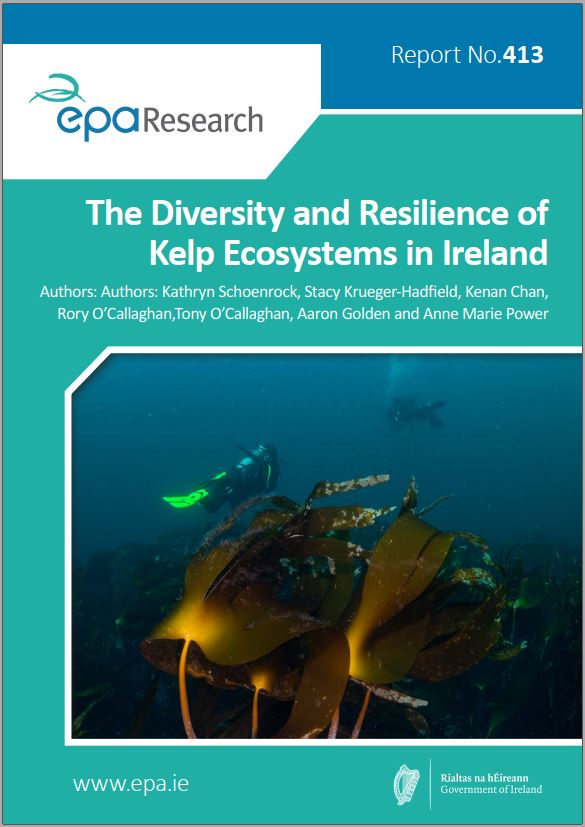Research 413: The Diversity and Resilience of Kelp Ecosystems in Ireland
Authors: Kathryn Schoenrock, Stacy Krueger-Hadfield, Kenan Chan, Rory O’Callaghan, Tony O’Callaghan, Aaron Golden and Anne Marie Power
Summary: In Ireland, Kelp forests can be found along rocky shorelines and dominates rocky substrata along the Irish coastline (approximately 3010 km out of the 7524 km of national shoreline). The report makes recommendations concerning monitoring and preserving kelp ecosystems nationwide. A range of resilience metrics was assessed for subtidal kelp forests in Ireland to better understand how to monitor, manage and simply understand these systems and their potential responses to climate shifts in nearshore ecosystems.

Identifying Pressures
Kelp forests can be found along rocky shorelines in temperate to Arctic coastlines on six continents. In Ireland, kelp dominates rocky substrata along moderately exposed coastline (approximately 3010 km out of the 7524 km of national shoreline). These ecosystems potentially provide a range of ecosystem services (ESs), including important primary and secondary production in local or adjacent habitats, carbon fixation and sequestration, and protection of coastal habitats via physical attenuation of wave action, food web and ecosystem structuring, and recreational activities , however there is still little known about them in this geographic range. We have little understanding of kelp forest food webs in Ireland, such as how kelp contributes carbon to food chains, which fisheries rely on kelp for subsistence or habitat, and what functional redundancy exists in kelp communities to buffer them from the effects of climate change or “fishing down food webs”. Furthermore, we have no accurate measure of how much kelp exists in Ireland, or of its distribution across depths, along coasts and over seasons. Gathering these data would require a more intensive monitoring and field programme.
Despite major knowledge gaps in understanding kelp ecosystems, anthropogenic stressors are predicted to affect Irish populations. These include warming oceans, overgrazing due to ‘’fished down food webs’’, eutrophication, sedimentation, and wild harvesting. The ability to recover from threats can be termed “resilience”, defined as the ability of an ecosystem to recover and maintain normal ecological function after a disturbance event. We have examined the resilience of subtidal kelp Cuvie forests in Ireland using both evolutionary and ecological metrics.
Informing Policy
Given the multiple stressors facing kelp ecosystems globally and their importance in providing ESs, we do not recommend wild harvesting of kelp in Ireland. In particular, as no routine resource monitoring currently takes place in Ireland, it would be impossible to ensure that wild kelp harvesting is sustainable and that populations would recover and maintain ESs. There is no tried-and-tested method for repairing or restoring these systems after they collapse. Therefore, the approach to their management in Ireland should be cautious. Hand in hand with protecting kelp resources is the need to conduct monitoring.
This cautious approach should be taken to protect, conserve and manage this wild resource either under existing legislation, such as the Habitats Directive, or through other legal instruments, including international conventions such as the Convention for the Protection of the Marine Environment of the North-East Atlantic (OSPAR). Filling these knowledge gaps would provide important information for calculating Ireland’s “blue carbon” mitigation strategies for meeting climate change Paris Agreement and EU Green deal targets. These ecosystems should be specifically identified in both the Marine Strategy Framework Directive and the Water Framework Directive as monitoring targets for good environmental or ecosystem status.
Developing Solutions
The report makes recommendations concerning monitoring and preserving kelp ecosystems nationwide. A range of resilience metrics was assessed for subtidal kelp forests in Ireland to better understand how to monitor, manage and simply understand these systems and their potential responses to climate shifts in nearshore ecosystems. Our data collection constitutes one of the finest-scale population-level sampling efforts in marine algae along a national coastline, and the results should inform both the management and the conservation of marine habitats. The bank of microscopic kelp forms in nearshore ecosystems is best detected with genomic techniques, and we use these to describe the occurrence of microscopic kelp forms in sites around Ireland. This is a necessary first step towards understanding the evolutionary ecology of these important taxa. This provides knowledge about potential kelp recruitment dynamics and therefore the resilience of these ecosystems to climate change and other disturbance events.
Past records of kelp ecosystems are insufficient to monitor the distribution and abundance, and the status, trends and ecosystem health of kelp ecosystems. We need to shift towards whole ecosystem records that describe the abundance of not only kelp species, but also associated taxa that may act as indicators of the health of the ecosystem. Monitoring the status of and trends in the distribution and abundance of kelp should be prioritised. We suggest that this would be best achieved with a mix of citizen science and state-sponsored monitoring programmes (to ensure optimal regional coverage). For the latter, the use of remote-sensing tools using sonar that is ground-truthed with data collected from drop-down cameras and by scuba divers should be achievable and would allow periodic monitoring. Schemes to continue monitoring kelp ecosystems drawing on citizen scientists, especially with digital dive slates for scuba divers, are important avenues to pursue.
Download the Kelp forest infographic designed for KelpRes outreach.
https://www.epa.ie/media/epa-2020/research/epa-funded-research/Report-cover-413.jpg